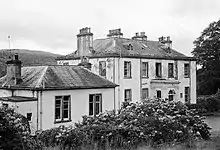Ballechin House
Ballechin House was a Georgian estate home near Grandtully, Perthshire, Scotland. It was built in 1806,[1] on the site of an old manor house which had been owned by the Steuart family since the 15th century.[2] This house, which stands in Ballechin Wood, is the subject for a popular local ghostlore story.

History
In 1834 Major Robert Steuart (1806-1876)[3] inherited the house and rented it to tenants whilst he served in the Indian Army.[2]
Ghostlore
During his time in India, Steuart came to believe in reincarnation and transmigration.[4] He returned to the house in 1850 and lived there with numerous dogs: he is reported to have stated that he would return in the form of a dog.[3][4] Major Steuart was unmarried, but local gossip linked his name with that of his much younger housekeeper who died there in 1873.[3][4] After the Major's death, the house was inherited by his nephew John Skinner who assumed the name Steuart.[5] Fearing that his uncle would reincarnate in the form of one of his dogs, the new owner reportedly shot them all.[4] From this story came the legend that Robert Steuart was forced to haunt the house as a disembodied spirit.[2] The first reported haunting at the house took place in 1876; the witness was a maid in the house.[2][6]
Society for Psychical Research investigation
In 1897 an investigation of the house was organized by John Crichton-Stuart, 3rd Marquess of Bute, with the assistance of paranormal researchers from the Society for Psychical Research.[2][6] Ballechin House was known as "The Most Haunted House in Scotland",[6][7] with several similarities to the Borley Rectory haunting, including the alleged apparition of a ghostly nun.[2] The team of investigators from the Society for Psychical Research included Colonel Lemesurier Taylor and the notorious Ada Goodrich Freer.[8][9] In 1899, The Alleged Haunting of B---- House by Crichton-Stuart and Freer was published, and serialised in The Times, containing a journal of the phenomena kept by Freer.[2]
J. Callender Ross who had stayed at the house stated in The Times that there was no evidence for any supernatural disturbances and considered the whole investigation to be fraudulent.[10] The SPR later removed material from a volume of their Proceedings on the investigation and denounced Freer. Psychical researcher Frederic W. H. Myers who was originally supportive of the investigation wrote in a letter to The Times he "greatly doubt[ed] whether there was anything supernormal" at the house.[11]
Trevor H. Hall revealed that Freer was an unreliable investigator, had deceived the SPR, plagiarised material and lied about her own life.[11][12]
Ballechin House was uninhabited by 1932, and most of the house was demolished in 1963, after a fire, leaving only the former servants quarters and outbuildings.[1][2] Also lost was art work and furniture which had been collected by generations of the Steuart family, including many pieces from the far east, reflecting successive lairds' involvement in the British East India Companymand the Scottish Indian company Jardine Skinner, owned by John Skinner Steuart and the Jardine family.
References
- Graeme Virtue (31 October 1999). "Favourite haunts". The Sunday Herald.
- "Ballechin House". The Element Encyclopedia of the Psychic World. Harper Element. 2006. p. 59.
- Ann Lindsay Mitchell (1994). Mystical Scotland. Dundurn Press. p. 44. ISBN 1-85877-005-X.
- Hall (1980) p.74
- Hall (1980) p.100
- "The spirit of sanity". Scotland on Sunday. 9 March 1997.
- Laura Miller (28 August 2006). "Ghost world". Salon.com.
- Price, Harry. (1945). Poltergeist Over England. Country Life. p. 224
- Laurel Brake; Marysa Demoor (2009). Dictionary of nineteenth-century journalism in Great Britain and Ireland. Academia Press. p. 231. ISBN 978-90-382-1340-8.
- "The 'unhaunted' Ballechin House". Perthshire Diary.
- Hilary Grimes (2011). The Late Victorian Gothic: Mental Science, the Uncanny, and Scenes of Writing. Ashgate Publishing. pp. 87–90. ISBN 978-1-4094-2720-9.
- Grant, John. (2015). Spooky Science: Debunking the Pseudoscience of the Afterlife. Sterling Publishing. pp. 46-49. ISBN 978-1-4549-1654-3
- Ada Goodrich Freer; John, Marquess of Bute (1899). The Alleged Haunting of B---- House. George Redway.
- Trevor H. Hall (1980). The Strange Story of Ada Goodrich Freer. Gerald Duckworth and Company. ISBN 0-7156-1427-4.
Further reading
- Hilary Grimes (2011). The Late Victorian Gothic: Mental Science, the Uncanny, and Scenes of Writing. Ashgate Publishing. pp. 87–90. ISBN 978-1-4094-2720-9.
External links
- Ballechin House, Royal Commission on the Ancient and Historical Monuments of Scotland
- Ballechin House, Visit Dunkeld
- The 'unhaunted' Ballechin House, Perthshire Diary